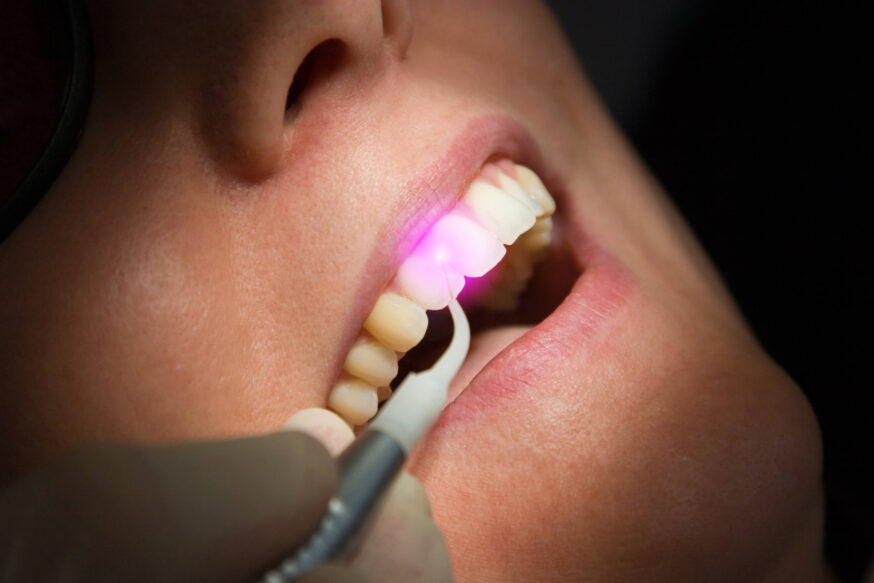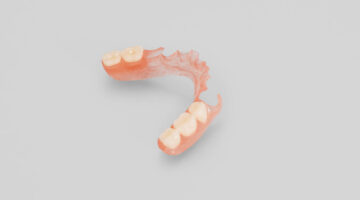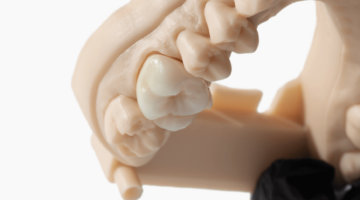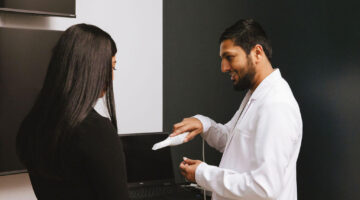The future is now. Along with intraoral scanners, 3D printing, and other advancements in dental technology, dental lasers have transformed patient experience at practices.
Yes, lasers. The term LASER (Light Amplification by the Stimulated Emission of Radiation) was introduced in 1959 while the first laser was developed in 1964. Almost immediately, the desire to explore its use in dental procedures by dentists began. However, the use of lasers in dentistry wasn’t certified by the US Food and Drug Administration (FDA) until May 1997. And the market has grown so much over the years that it’s estimated to reach $321.5 million by 2027.
Laser treatment can be pain-free, which eliminates the need for anesthesia. Meaning pregnant women, children, and people with an allergy to anesthesia can be safely treated.
A dental laser is used for both hard (tooth) and soft (gum) tissue treatment. Also, it allows you to safely perform many dental procedures, is effective for faster healing, less bleeding, treatment of periodontal diseases, and much more. And can help patients avoid root canals in the case of a minor root infection.
Before lasers became mainstream in the ‘90s, oral care was done almost exclusively by scraping or drilling. Now with lasers, dentistry tasks aren’t painful or invasive.
Lasers are an innovative piece of dental technology that many practices invest in. Are they right for your practice? This article intends to help you decide if getting one is the right thing to do and how to choose the right laser for your practice and budget.
Types of dental lasers
There are various methods to classify dental lasers, depending on:
- The lasing medium used, such as gas and solid laser.
- Tissue applicability, hard tissue, and soft tissue lasers.
- Range of wavelength and risk associated with laser application.
There are 4 common types of dental lasers: Diode, Nd:YAG, Erbium, and CO2– they each have different wavelengths, active medium, and benefits.
Diode laser benefits
Diode laser is best for soft tissue surgery and its wavelengths are 810, 940, and 980nm.
It’s less invasive than a dental drill and people have said that it improved their treatment experience, specifically, faster healing due to minimal bleeding, less swelling, and postoperative discomfort.
Nd:YAG laser benefits
The Nd:YAG lasers operate at a wavelength of 1064nm.
It has the highest potential for damaging soft and hard tissues as well as implant surfaces and is good for minimal cellular destruction, tissue swelling, hemostasis, increased visualization of surgical sites, and reduced postoperative pain.
Patients find this procedure non-invasive and experience minimal discomfort.
However, with the use of CO2 and Nd:YAG lasers, thermal side effects like—melting, cracking, and carbonization of the root—have been reported.
Erbium laser benefits
Erbium emits light at different wavelengths because it’s built with two separate crystals: the erbium-doped yttrium-aluminum-garnet, the wavelength’s 2940 nm, and the erbium, chromium–doped yttrium-scandium-gallium-garnet at 2780 nm.
While using erbium lasers dentists observed: painless cavity preparation and caries removal, enamel and dentine modification for bonding, and smear layer elimination. Also, recent research focused on the importance of its family of laser wavelengths in periodontics, including debridement.
It has a shallow thermal penetration depth allowing it to ablate sound and carious enamel and dentine. It can reduce the microleakage of composite restorations and increase the resistance of tooth minerals to dissolution by acid.
CO2 laser benefits
CO2 lasers have long wavelengths of around 9,300 – 10, 600 nm.
It’s used in the removal of lesions in soft tissue periodontal surgery. The major advantage of CO2 laser is its wavelength, it has a high affinity for water which allows for rapid soft tissue removal and hemostasis with a shallow depth of penetration.
The CO2 laser is the most commonly used in dentistry.
Using dental lasers on soft tissue
When correctly used lasers enable soft tissue to be precisely and safely removed.
Several lasers have been cleared by the FDA for this purpose but the most popularly used laser for soft-tissue treatments is the diode laser.
One of the most effective uses of soft tissue lasers is in treating patients with periodontal disease and physiologic gingival pigmentation.
Using dental lasers on hard tissue
In hard tissue applications, a laser is used for bleaching, restorative removal and curing, cavity preparation, dentinal hypersensitivity, growth modulation, caries prevention, and diagnostic purposes.
Erbium lasers are the best for hard tissue treatment. It can prepare enamel, dentin, caries, cementum, and bone in addition to cutting soft tissue.
Also, these lasers can reduce or eliminate vibrations, the whine of drills, microfractures, and the discomfort caused by high-speed handpieces.
What to consider when purchasing a dental laser
Dental lasers have become more common because of the optimization of their wavelength for human tissue interactions.
An example is diode laser (840, 670-830, 655- 1064, and 488) nm, which is used for implantology, curing, oral hygiene, tooth bleaching, etc.
The reason why more dentists don’t use lasers is because every dental procedure can’t be handled with it.
However, you’ll benefit greatly from investing in dental lasers if your practice performs hard and soft tissue procedures such as:
- Complications of wisdom teeth
- Dental fillings
- Gum reshaping
- Growth removal
- Tongue ties, etc
Also, there may be dental procedures you need to expand at your practice whose process would be faster when performed with lasers. For example:
- Removal of tissues responsible for sleep apnea
- Removal of oral tumors (malignant)
- Regeneration of damaged nerves
- Biopsy of oral tissues
Some of the FDA-approved surgical procedures where lasers can be used are cosmetic surgery, general surgery, refractive eye surgery, and dental procedures.
If you’re planning to expand your medical knowledge or seek out new opportunities in your field, consider getting a dental laser certification.
While some states may allow you to operate lasers after some basic training, you may be limited in the number of services you can perform. To avoid this, ensure the course you take is approved; otherwise, you could end up retaking it from a verified provider. Collect the right documentation of course completion for your records and provide it to the Academy of Laser Dentistry.
Technology is always evolving; having a laser in-house puts you and your staff at the forefront of the learning curve (keeping them very engaged in your practice) while offering better patient care. Your practice is also seen as capable, and advanced, and this may help you record a higher case acceptance rate from your patients.
The time and cost of dental laser training depend on the course and place of learning; you may spend anywhere from 6-72 hours learning while the cost may range from a humble amount like $69 upwards to $5,700.
Lasers in dentistry
When considering investments like dental lasers, prioritize your patients and the benefits they will receive from the tools. Enlisting dental technology is the way to treat the modern patient and utilizing advanced instruments makes sudden and lasting positive impacts.
Beyond lasers, the increase in adopting intraoral scanners shows the industry’s commitment to remaining innovative. Whether your practice currently uses an intraoral scanner and lasers or are weighing the pros and cons of investing in one piece of equipment, Dandy is here to help. We provide practices who partner with us a free intraoral scanner, leaving your practice the budget to invest in more, new technology. Sound interesting? Let’s chat!



